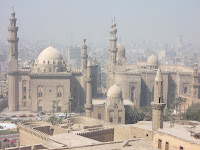 |
| Mamluk style Sultan Hassan Mosque |
Ibn Tulun Mosque's simple Addasid style curves and lines are reminiscent of the great Persian mosques in Iran. Built around 1,130 years ago sultan Ibn Tulun it is the oldest mosque in Cairo. Well restored today you can climb the spiral minaret and access the roof for even better views over the dusty Cairo skyline, great.
Wandering through the narrow lanes eventually I find my way to the green and peaceful oasis of the Citadel View Restaurant in Al-azhar Park. It's an expensive lunch stop but, the pleasant vista across the park towards the Citadel, eases the pain.
Tuesday 26: Back in Islamic Cairo, the ornate Mosque-Madrassa of Sultan Hassan, built 650 years ago, is regarded as the best example of early Mamluk architecture in the city. From here I climb up to the hilltop fortress that was home to generations of Egypt's sultans, the Citadel. Saladin started building it 837 years ago as a defence against potential Crusader attacks from their Holy Land stronghold. It was subsequently enlarged by the Mamluks before it fell to Napoleon's troops and subsequently, when the French withdrew, into the hands of an Ottoman soldier, Mohammed Ali. A lieutenant in the Turkish army Mohammed Ali's rise to power was both swift and brutal. On 1st March 1811 he invited the Mamluk beys to a banquet in the Citadel in honour of his son's impending departure to Mecca. When the feast was over and the procession of mounted Mamluks, dressed in all their finery, rode towards Bab al-Azab gateway the gates slammed shut. First gunfire rained down on them and then Mohammed Ali's troups waded in with axes and swords to finish the slaughter. No Mamluks survived. He went on to destroy most of the Mamluk architecture in the Citadel and replace it with the Turkish style multi-domed Mosque of Mohammed Ali that still dominates Cairo's skyline. Today the Citadel is a large complex filled with mosques, old palaces and mediocre museums.
Walking back towards Downtown Cairo I stop for a kushari lunch (a mixture of rice and various noodles topped with lentils, tomato sauce and crispy onions) before visiting the Blue Mosque and adjacent house.
Wednesday 27: The Museum of Islamic Art is interesting but no photos.
Slideshow of Islamic Cairo.











No comments:
Post a Comment